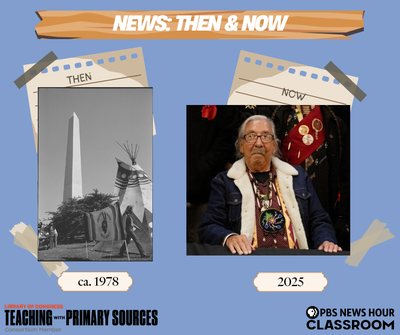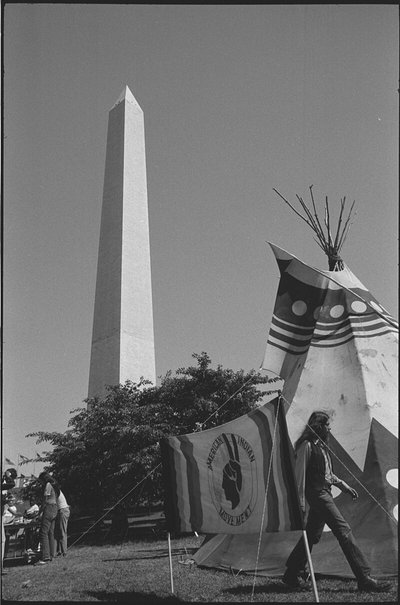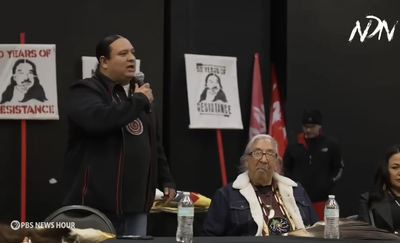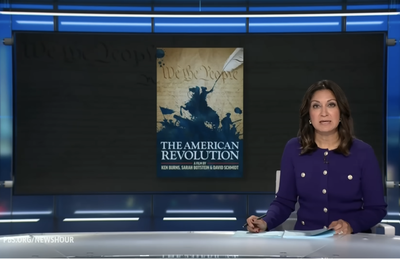NOTE: If you are short on time, watch the video and complete this See, Think, Wonder activity: What did you notice? What did the story make you think? What would you want to learn more about?
SUMMARY
To many supporters, Leonard Peltier was a political prisoner unjustly punished for his activism with the American Indian Movement. To his critics, he is a remorseless killer of two FBI agents in 1975, a charge he denies. President Biden commuted Peltier’s sentence, restricting him to home confinement. Fred de Sam Lazaro spoke with Peltier on the Turtle Mountain Indian Reservation in North Dakota.
View the transcript of the story.
News alternative: Check out recent segments from the NewsHour, and choose the story you’re most interested in watching. You can make a Google doc copy of discussion questions that work for any of the stories here.
WARM-UP QUESTIONS
- Who is Leonard Peltier?
- Where does Peltier live today?
- What were the circumstances that led to Peltier's arrest and conviction, according to Nick Estes and Michael Clark?
- Why did Peltier join the American Indian Movement (AIM) and become a lifelong activist?
- How did the U.S. government and tribal governments collude (cooperate in secret or in an unlawful way) to take natural resources and land away from Native Americans, according to Peltier?
ESSENTIAL QUESTIONS
Why do you think Leonard Peltier's case has drawn so much attention over the years?
Media literacy: Which parts of the interview struck you as particularly interesting and why?
NEWS: THEN & NOW
The News: Then & Now section of the Daily News Lessons allows students to see connections between current and past news events. News: Then & Now provides historical context into issues students see in the news using primary sources from the Library of Congress.
PBS News Hour Classroom is a member of the Library of Congress' Teaching with Primary Sources (TPS) Consortium. Learn more about News Hour's TPS project, Journalism in Action, a website focused on the role of journalism and civics in U.S. history, and sign up for the newsletter here.

Then:
The American Indian Movement (AIM)
Inspired by civil rights activists and the anti-war movement of the 1960s, the American Indian Movement (AIM) was launched in 1968 to fight back against racism and poverty in Native American communities and to demand restitution for treaty rights long violated by the United States government. AIM drew national attention through their many protests, including a two-year occupation of Alcatraz Island in California’s San Francisco Bay and a 71-day occupation at Wounded Knee on the Pine Ridge Reservation in South Dakota.

Tipi with sign "American Indian Movement" on the grounds of the Washington Monument, Washington, D.C., during the "Longest walk." via Library of Congress
In 1978, AIM launched the Longest Walk across the country in support of tribal sovereignty (the right to rule oneself) and drew attention to a series of proposed federal bills that AIM said would negate Indian Treaties, cut off social services and threaten land and water rights.
Now:
Groups like NDN Collective continue to fight for rights for Indigenous people.

Credit: NDN Collective via PBS News Hour story
WHAT STUDENTS CAN DO
Check out our Journalism in Action's Native American case study to learn more about how journalists covered Native issues in U.S. history. Journalism in Action: Civic Engagement and Primary Sources Through Key Moments in History is a project supported by the Library of Congress, which focuses on civic education, media literacy, history and more.

Credit: Screenshot of PBS News Hour Classroom's Journalism in Action: Civic Engagement and Primary Source Through Key Moments in History website
Sign up to receive our weekly newsletter with Daily News Lessons and community events.
To provide feedback on News Hour Classroom's resources, including this lesson, click here.





